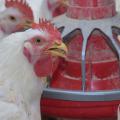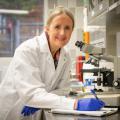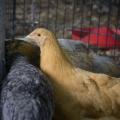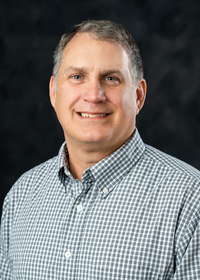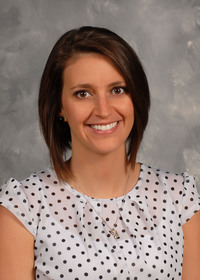Contents of chicken egg
The avian egg, in all its complexity, is still a mystery. A highly complex reproductive cell, it is essentially a tiny center of life. Initial development of the embryo takes place in the blastoderm. The albumen surrounds the yolk and protects this potential life. It is an elastic, shock-absorbing semi-solid with a high water content. Together, the yolk and albumen are prepared to sustain life - the life of a growing embryo - for three weeks, in the case of the chicken. This entire mass is surrounded by two membranes and an external covering called the shell. The shell provides for an exchange of gases and a mechanical means of conserving the food and water supply within.
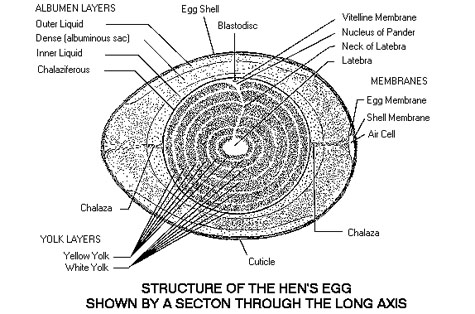 The egg is formed in the mature hen by a reproductive system composed of an ovary and oviduct. Most females have two functional ovaries, but chickens and most other birds have only one ovary and one oviduct. In this oviduct, all parts of the egg, except the yolk, are formed. It is divided into five distinct regions: (1) infundibulum or funnel, (2) magnum, (3) isthmus, (4) uterus or shell gland, and (5) vagina.
The egg is formed in the mature hen by a reproductive system composed of an ovary and oviduct. Most females have two functional ovaries, but chickens and most other birds have only one ovary and one oviduct. In this oviduct, all parts of the egg, except the yolk, are formed. It is divided into five distinct regions: (1) infundibulum or funnel, (2) magnum, (3) isthmus, (4) uterus or shell gland, and (5) vagina.
The yolk is formed in the follicular sac by the deposition of continuous layers of yolk material. Ninety-nine percent of the yolk material is formed within the 7-9 days before the laying of the egg. When the yolk matures, the follicular sac ruptures or splits along a line with few, of any, blood vessels. If any blood vessels cross the stigma, a small drop of blood may be deposited on the yolk as it is released from the follicle. This causes most blood spots in eggs. After the yolk is released from the follicle, it is kept intact by the vitelline membrane surrounding it. The release of the yolk from the ovary is called "ovulation."
After its release from the follicle, the yolk falls into the hen's abdominal cavity. The infundibulum of the oviduct quickly engulfs the yolk with its thin, funnel-like lips. The yolk quickly enters the magnum section of the oviduct where the dense portion of the albumen is added. The shape of the egg is largely determined in this section.
The magnum of the oviduct is divided from the isthmus by a narrow, translucent ring without glands. The isthmus is smaller in diameter than the magnum. It is here the two shell membranes form. The shell membranes loosely contain the yolk and dense white until the rest of the albumen is added in the uterus.
The shell is added in the uterus or shell gland portion of the oviduct. The shell is composed mainly of calcium carbonate. It takes about 20 hours for the egg shell to form. If the hen lays brown eggs, the brown pigments are added to the shell in the last hours of shell formation.
The chalazae, two cord-like structures which keep the yolk centered in the egg, first appear in the uterus. The chalazae also function as an axis around which the yolk can rotate and keep the germinal disc in hatching eggs uppermost at all times.
In the last portion of the oviduct, the vagina, a thin, protein coating called "bloom" is applied to the shell to keep harmful bacteria or dust from entering the egg shell pores. The egg passes through the oviduct small end first, but is laid large end first. In the vagina, the egg is turned horizontally just before laying. If the hen is disturbed on the nest, the egg may be prematurely layed small end first. "Oviposition" is the act of pushing the egg from the oviduct.
When an egg is laid, it fills the shell. As it cools, the inner portion of the egg contracts and forms an air cell between the two shell membranes. A high quality egg has a tiny air cell, indicating the egg was collected soon after being layed and was stored properly. The air cell is usually located in the large end of the egg where the shell is most porous and air can enter easily.
Publications
News
STARKVILLE, Miss. -- Until an avian flu vaccine for chickens or other alternative is federally approved, commercial poultry operations in the U.S.
STARKVILLE, Miss. -- If egg prices have seemed higher than ever lately, it’s because they are, and consumers can place much of the blame squarely at the feet of the ongoing bird flu outbreak.
With highly pathogenic avian influenza, or HPAI, in the environment in Mississippi, owners of backyard flocks have to take extra steps to keep their chickens healthy.
Avian influenza poses an extremely low risk to human health and none to food safety in Mississippi, but its presence poses a risk to backyard flocks and the state’s $3 billion commercial poultry industry.


